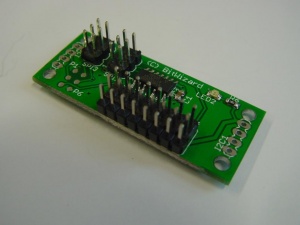Difference between revisions of "Servo"
| Line 43: | Line 43: | ||
2-3: ICSP enabled; programming the MCU over the 6-pin connector. This connector may be marked SPI1 or SPI3 (near the edge of the board, furthest from the CPU.)<br> |
2-3: ICSP enabled; programming the MCU over the 6-pin connector. This connector may be marked SPI1 or SPI3 (near the edge of the board, furthest from the CPU.)<br> |
||
== |
== Protocol == |
||
For the intro to the SPI and I2C protocols read: [[SPI versus I2C protocols]] |
|||
To control the servos, you need to send things over the bus to the PCB. The [[spi_servo 1.0_protocol|protocol is explained here]]. |
|||
The board specific protocol can be found here: [[Servo_1.0_protocol]] |
|||
You should also read the [[General_SPI_protocol notes]]. |
|||
For arduino, a sample PDE is available, called ardemo_lcd.pde, also at BitWizard software download directory . |
|||
This is a demo to send things using SPI to the lcd board. The SPI routines there are applicable for SERVO boards as well. |
|||
== The software == |
== The software == |
||
Revision as of 17:23, 11 May 2012
This is the documentation page for the SPI_servo and I2C_SERVO boards.
Overview
This module enables you to easily control upto 7 servomotors over an SPI or I2C interface, while needing minimal resources from your CPU.
The PCB is equipped with two SPI or I2C connectors, so daisychaining multiple SPI or I2C modules is possible.
This allows you to control a chain of boards with only 4 data lines (MOSI, MISO, SS and SCK) for SPI or two lines (SDA, SCL) for I2C. This is not only pin-saving, but is is also possible do daisy-chain multiple modules (we will be releasing even more boards with other functions in the very near future)!
The board can be used with all microcontrollers, such as the Atmel AVR, Arduino/Freeduino boards, Microchip PIC, Raspbery PI etcetera.
For small servos, the power supplied by the SPI or I2C connector is enough. However current surges of up to a whole ampere are easily achieved even when two or three smaller servos need to move simultaneously. For larger servos however, the voltage drop may be to high. We suggest conneting an auxillary 5V power source to the PCB, and move the jumper.
External resources
Datasheets
The CPU: http://www.atmel.com/dyn/resources/prod_documents/doc8006.pdf
Additional software
Related projects
Pinout
The pinout is standard for servo-motors; Pin 1 is GND (near the edge of the board) Pin 2 is VCC (5V) Pin 3 is data
LEDs
The only LED is a power-LED.
Jumper settings
Solder jumper (on bottom layer): ICSP-Enable. CAUTION! Pin 1 and 2 are connected by a narrow PCB track. Cut this if you want to change this jumper setting.
1-2: Default: Both SPI connectors connected in parallel.
2-3: ICSP enabled; programming the MCU over the 6-pin connector. This connector may be marked SPI1 or SPI3 (near the edge of the board, furthest from the CPU.)
Protocol
For the intro to the SPI and I2C protocols read: SPI versus I2C protocols
The board specific protocol can be found here: Servo_1.0_protocol
You should also read the General_SPI_protocol notes.
For arduino, a sample PDE is available, called ardemo_lcd.pde, also at BitWizard software download directory .
This is a demo to send things using SPI to the lcd board. The SPI routines there are applicable for SERVO boards as well.
The software
Default operation
Future hardware enhancements
Future software enhancements
Changelog
1.2
- Added jumper/power connector for (external) servo power.
1.0
- Initial public release
